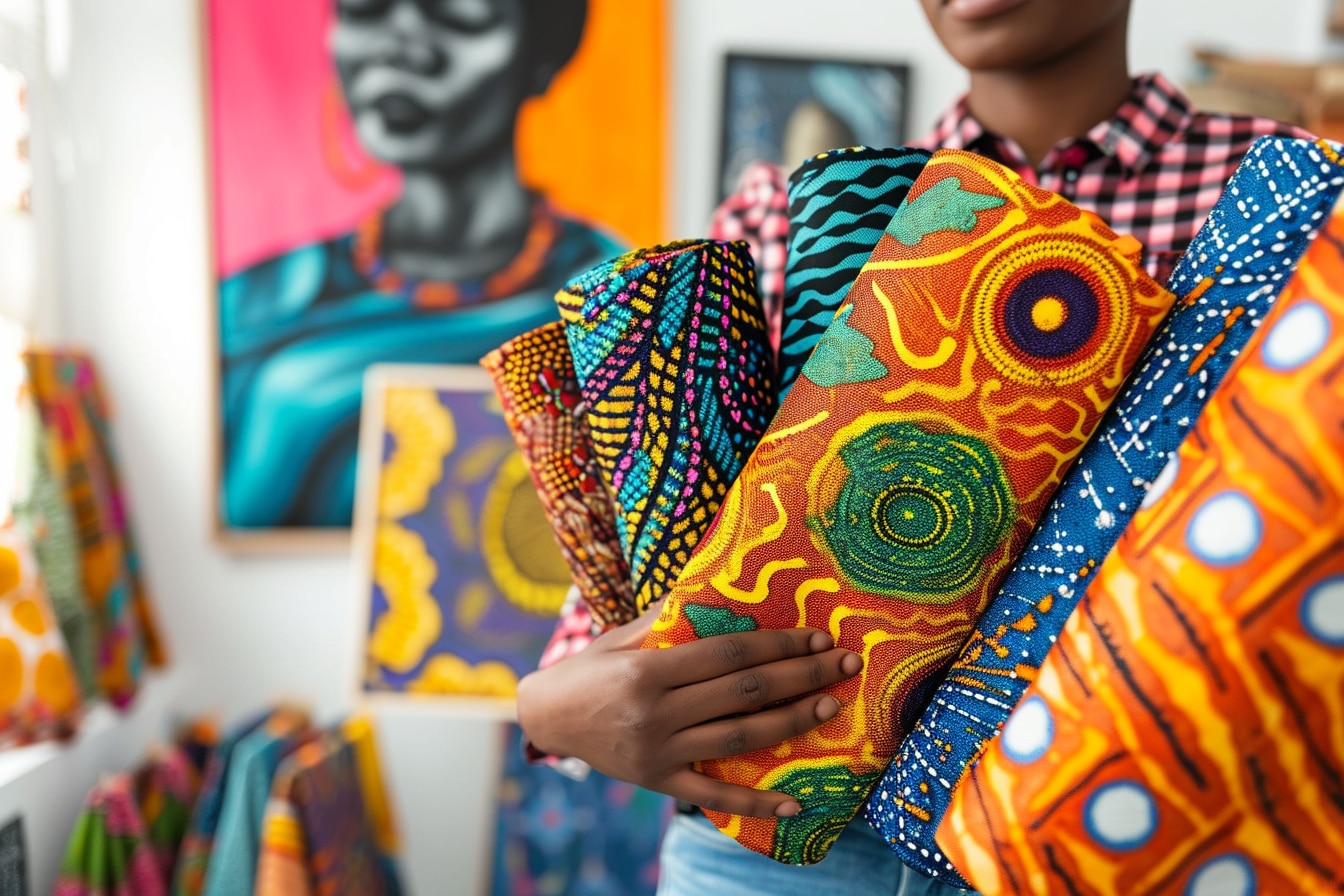The world of African fashion is as rich as it is varied, blending ancestral traditions with current trends. The soul of this fashion is largely expressed through its emblematic fabrics, which tell stories and carry deep meanings. To better understand this universe, we’ll take a closer look at the most emblematic fabrics used in African fashion. We’ll start by exploring wax, with its origins, unique characteristics and diverse uses. Next, we’ll delve into the world of bogolan, discovering its artisanal manufacturing process and rich symbolism. Finally, we take a look at kente, a prestigious fabric whose history blends with modernity in contemporary fashion creations. To find out more, discover our tips and advice for adopting African fashion style.
Wax
Wax fabric, the vibrant heart of African dressing, seduces with its explosion of color and captivating patterns. Its particularity lies in a wax technique that gives it a slightly shiny appearance and a rigid texture. This wax printing method, which originated in Indonesia but has been adopted and adapted in Africa, enables us to create complex designs that blend traditional African symbols with modern influences.
From the bustling markets of Dakar to those teeming with Lagos, rolls of wax spread like rainbows across the land, offering an infinite palette for couturiers. Couturiers transform this fabric into creations ranging from majestic boubous to fitted contemporary dresses. Each pattern tells a story or conveys a message codified in African cultures – wax is much more than just a fabric; it’s a visual language.
Diverse uses: Wax finds its place not only in clothing, but also in interior furnishings and fashion accessories. Whether enhancing a sofa with colorful cushions or adding a touch of the exotic with a stylish handbag, wax embodies creative versatility.
With its roots as diverse as its uses, wax ideally reflects the hybridity inherent in African fashion: a subtle blend of respect for tradition and adoption of global trends. Living proof of this link between past and present, it continues to inspire designers the world over, who see it as an inexhaustible source of innovation while remaining deeply rooted in its cultural heritage.
Bogolan: manufacturing process and symbolism
Bogolan, the fabric of traditional West African dress, is distinguished by an ancestral manufacturing process using natural raw materials. The art of bogolan is based on the use of iron-rich clays and mud to dye hand-woven cotton. These raw materials are carefully selected and applied to the fabric in precise patterns, often rich in meaning.
Each stage reflects an alchemy of skill and patience: first, the fabric is soaked in a decoction of leaves or bark, which acts as a mordant. The artists then use sticks or spatulas to draw with the fermented mud, before the fabric is exposed to the sun to print the black motifs on an ochre background.
As for the symbolism of bogolan, it’s revealed in every figure and line drawn. It’s a visual language in which geometric expressions refer to proverbs, historical situations or the social identity of the wearer. In this way, bogolan garments are not only visually beautiful; they are also carriers of an esoteric culture, passing on a dignified heritage for generations.
This mystical fabric is now attracting attention on the international catwalks, where it is appearing in a new light, blending with contemporary cuts while preserving its deep-rooted essence. Bogolan resonates as a dialogue between past, present and future, where each creation tells a unique story.
The kente
Timeless and of immeasurable cultural richness, kente weaves its historical fabric at the heart of African sartorial traditions. Originating in Ghana’s Ashanti Empire, kente was originally worn by royalty and high-ranking personalities. Its local name, “nwentoma”, literally means “hand-woven fabric”, recalling theextraordinary craftsmanship of the Akan people.
With its colorful geometric patterns forming a veritable visual patchwork, every shade and design of kente carries a symbol, conveying specific messages according to ancestral legends. Bright colors – notably gold, evoking wealth and royal status; green, symbolizing fertility; and red, illustrating political and spiritual ties – make kente a fabric that tells a story.
In a dynamic conservation movement, this prestigious fabric has adapted to changing tastes while preserving its symbolic essence. Today, it embodies African modernity on international catwalks. Proudly embraced for its deep roots as much as for its contemporary reinterpretation possibilities, kente dresses traditional outfits as well as haute couture creations, demonstrating its ability to transcend cultural and temporal boundaries.
Far from being frozen in time, this perennial textile now inspires designers and stylists who dare to blend tradition and innovation. They play with its archetypal motifs by resizing its graphics or introducing it in dashes on modern silhouettes. For if fashion is a perpetual restart, kente remains an enduring symbol of a rich African heritage that’s always on the move.
We recommend these other pages:
- What are the main materials used in African fashion?
- What are the key accessories for a look inspired by African fashion?
- How do you mix African fashion with Western pieces for a unique look?
- Impact of prints on African fashion expression
- Which colors are most often dominant in African fashion, and how can they be used in an outfit?


Recent Comments